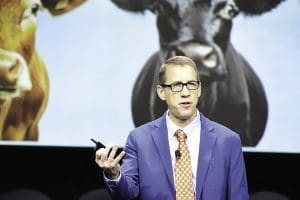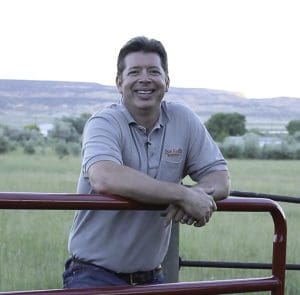By Burt Rutherford Contributing Editor

Mention El Niño to a group of beef producers and you’ll get a cheer. Mention La Niña and you’re apt to get one generally attributed to the Bronx.
CattleFax weather forecaster Matt Makins mentioned both during the annual CattleFax Industry Outlook session at the 2024 Cattle Industry Convention in early February. The large crowd of beef people were polite enough to remain silent when he told them to get ready for a transition to La Niña.
“We’re headed back to a La Niña,” he predicted. “This El Niño has pretty much peaked, it’s weakening. This spring will be neutral.” La Niña should be in place by this summer and, other than the seasons, will be the main factor affecting weather patterns for the next two to three years, Makins said.
“So rather than getting these wet storms from California across the southern states, we’re going to bring in a lot more cold. Next winter will be much colder and in some cases wetter for the northern states. Drought returns to the southern states.”

His forecast through July this year is for the southern states to be cold. “If you’re northwest, if you’re north, if you’re northeast, you’ll be warmer than average. Central Plains down through Texas to Florida, there will be areas that will be cooler than normal,” while the Central and Southern Plains should get some moisture.
Think back to 1983, 1992, 1995, 1998, 2007, 2010 and 2016. While not exactly analogous, those all were years where we came out of an El Niño and went into a La Niña, he told beef producers.
“It’s too early to discuss how strong and long-lasting this next La Niña event will be, but data and history suggest a significant event is ahead of us yet again,” he said.
Expansion Still on the Horizon
Turning to the market outlook, beef producers have experienced five years of liquidation, said CattleFax’s Kevin Good. And it’s likely that liquidation will continue at least through this year.
“From a big-picture standpoint, we have to recognize that we’ve got a situation where Mother Nature is going to be the major headwind,” he said. “So, despite the fact that we have and will have record-high calf values going forward, we need some help out of Mother Nature before it’s all said and done.”
More specifically, Good said that the big cow states are where we need better moisture if we’re going to turn things around. Many of those same states are where cull cows came from the past few years.
Cull cow culling rate was record high at 13.5 percent of the national herd two years ago and last year was 12.4 percent, the third highest in in the last 30 years. “So, unfortunately, even with our forecast for this year for cow slaughter to be down 700,000-plus, that would still be a mild liquidation pace,” he said. That rate is expected to be 600,000 beef cows and 100,000 dairy cows.
“On the heifer side, we did not expand last year,” he added. “Heifers on feed approached 40 percent of the total and that needs to be somewhere closer to 36 to 37 percent to get to a point where we would suggest some expansion on the heifer side.”
That means it’s going to take longer to rebuild numbers. In fact, Good predicted that cattle numbers may well remain tight through 2026. That translates to tighter beef supplies. “Take a look where we were in 2014 and 2015, because over the next three to four years, that’s where we’re going back to for per-capita supply.”
However, even though cattle prices will likely exceed those enjoyed in 2014 and 2015, this cycle is different. “When we go back to that 2012 to 2014 timeframe, we were already retaining heifers back at the ranch beginning in 2012,” said Mike Murphy, CattleFax analyst. “So, by the time we got to 2014 and 2015, and we really started to keep those heifers back at the ranch, you got a big upswing back into the market.”
That’s not happening now and may not happen for another year or more. So instead of a V-shaped trough at the bottom of the cattle cycle back then, expect more of a U-shaped trough, which will extend the duration of the rebuilding phase.
Looking at the cattle feeding sector, Good said there will be around 1 million fewer feeder cattle available for placement this year. “There’s going to be a chase for feeder cattle all the way through here and that’s going to be very supportive,” Murphy said. “We should feel very confident about having a calf market that’s going to be sustainable near $3 per cwt over the next few years.”
So, if your situation permits, it might be wise to keep a few of your best heifers.
“Historically, the way we look at the math, it takes about 4.6 calves to pay for a bred heifer,” Murphy said. That’s not a nailed-down number, because there are a lot of moving parts behind that when you analyze data over time. “The thing about a $3 calf market over the course of the next three or four years on average, it would imply that you could be buying bred females for about $2,400 and they’re going to make you some money.”


Cattle Fax 2024 Cattle Prices Outlook
-
Fed Steer: Average $184 per cwt, up $9. Fed steer prices will range from $168 to $200 per cwt. Cattle feeder profitability will decline as competition for tighter feeder cattle and calf supplies results in record-high breakevens.
-
800-lb. Steer: Average $240 per cwt, up $20. Prices will range from $220 to $260 per cwt. Expect a volatile market and the lowest prices in the first quarter and possible advancement toward $260 or better in the second half.
-
550-lb. Steer: Average $290 per cwt, up $28. Highest prices are expected seasonally in the spring but should decline into the fall calf run, which should be modest.
-
Utility Cows: Average $115 per cwt, up $16. Prices should range from the upper $90s to $135.
-
Bred Cows: $2,600 per head, up $600. Regional variance and wide ranges will be seen based on age, quality and regional drought conditions.






